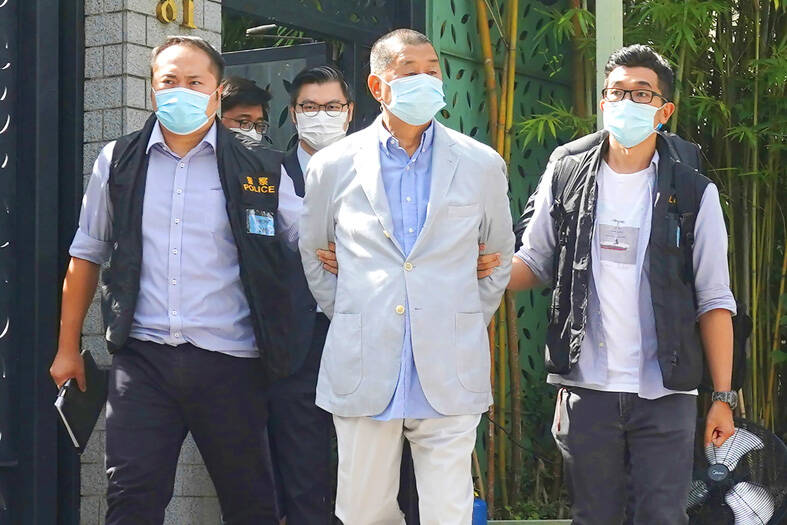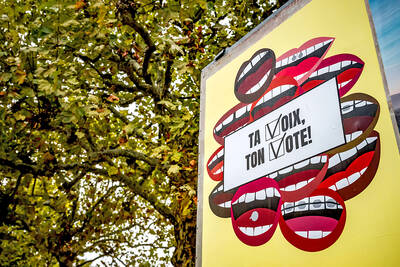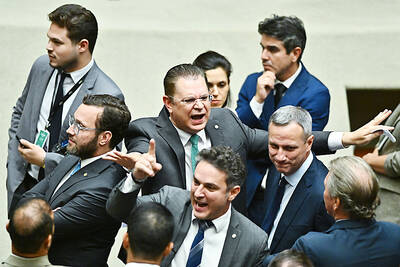A legal battle over Hong Kong’s effort to prosecute media tycoon Jimmy Lai (黎智英) on national security charges has made the once-unthinkable an imminent threat: moving sensitive cases to mainland Chinese courts.?
While Beijing has asserted the right to take over “complex” cases involving foreign nations since imposing a sweeping National Security Law on Hong Kong in 2020, it has so far not exercised the power. Instead, dozens of security cases are being prosecuted in local courts in the former British colony.
However, Lai’s foreign collusion case is testing Beijing’s patience for Hong Kong’s legal traditions, including an emphasis on transparency, precedent, judicial independence and the rights of the accused. Those values were on display last week, when Hong Kong’s highest court ruled that the founder of the now defunct Apple Daily newspaper could hire a renowned UK-based lawyer to defend him.

Photo: AP
Hong Kong Chief Executive John Lee (李家超), a Beijing appointee, responded by requesting China’s top legislative body to intervene and prevent lawyers based overseas from participating in such cases.
Hong Kong’s sole representative on that body subsequently suggested that defendants who failed to find local lawyers could find their cases transferred to Chinese courts, where national security trials are speedier and more secretive.
“If such difficulties really arise, they can be sent back to the mainland for trial,” Tam Yiu-chung (譚耀宗), a member of the National People’s Congress Standing Committee, told reporters on Sunday in Hong Kong.
Although Tam said such action would only be necessary in a “special case,” the threat illustrates the growing pressure on the judicial independence often cited as a reason for Hong Kong’s success as a global financial center.
Local courts risk being overruled by Beijing or losing control of cases altogether if they break with the government.
The issue of transferring cases to mainland courts was at the center of historically large and sometimes violent protests that erupted in 2019, which ultimately prompted Beijing to impose the security law and arrest Lai.
Those demonstrations were sparked by since-withdrawn extradition legislation that would have allowed the territory to send suspects in some criminal cases to the mainland.
“This will likely be viewed as a threat in the Hong Kong courts and legal profession to go along with Beijing’s demands or else, even when those demands are articulated indirectly through a supporter or the media,” said Michael Curtis Davis, a professor of law and International Affairs at Jindal Global University in India and a former law professor at the University of Hong Kong. “We can expect these sorts of threats to continue and be used in other high-profile cases when Beijing wants to pressure the courts or others to do its bidding.”
When asked to comment on whether a request had been made to transfer Lai’s case to the mainland, a spokesman for the government’s Security Bureau referred to Article 55 of the National Security Law.
That section allows Beijing to exercise jurisdiction over cases involving the four crimes listed in the law under certain conditions, such as being “complex due to the involvement of a foreign country.”
Hong Kong has so far charged at least 88 people on allegations related to those four crimes: secession, subversion, terrorism and foreign collusion.

A plan by Switzerland’s right-wing People’s Party to cap the population at 10 million has the backing of almost half the country, according to a poll before an expected vote next year. The party, which has long campaigned against immigration, argues that too-fast population growth is overwhelming housing, transport and public services. The level of support comes despite the government urging voters to reject it, warning that strict curbs would damage the economy and prosperity, as Swiss companies depend on foreign workers. The poll by newspaper group Tamedia/20 Minuten and released yesterday showed that 48 percent of the population plan to vote

PARLIAMENT CHAOS: Police forcibly removed Brazilian Deputy Glauber Braga after he called the legislation part of a ‘coup offensive’ and occupied the speaker’s chair Brazil’s lower house of Congress early yesterday approved a bill that could slash former Brazilian president Jair Bolsonaro’s prison sentence for plotting a coup, after efforts by a lawmaker to disrupt the proceedings sparked chaos in parliament. Bolsonaro has been serving a 27-year term since last month after his conviction for a scheme to stop Brazilian President Luiz Inacio Lula da Silva from taking office after the 2022 election. Lawmakers had been discussing a bill that would significantly reduce sentences for several crimes, including attempting a coup d’etat — opening up the prospect that Bolsonaro, 70, could have his sentence cut to

A powerful magnitude 7.6 earthquake shook Japan’s northeast region late on Monday, prompting tsunami warnings and orders for residents to evacuate. A tsunami as high as three metres (10 feet) could hit Japan’s northeastern coast after an earthquake with an estimated magnitude of 7.6 occurred offshore at 11:15 p.m. (1415 GMT), the Japan Meteorological Agency (JMA) said. Tsunami warnings were issued for the prefectures of Hokkaido, Aomori and Iwate, and a tsunami of 40cm had been observed at Aomori’s Mutsu Ogawara and Hokkaido’s Urakawa ports before midnight, JMA said. The epicentre of the quake was 80 km (50 miles) off the coast of

RELAXED: After talks on Ukraine and trade, the French president met with students while his wife visited pandas, after the pair parted ways with their Chinese counterparts French President Emmanuel Macron concluded his fourth state visit to China yesterday in Chengdu, striking a more relaxed note after tough discussions on Ukraine and trade with Chinese President Xi Jinping (習近平) a day earlier. Far from the imposing Great Hall of the People in Beijing where the two leaders held talks, Xi and China’s first lady, Peng Liyuan (彭麗媛), showed Macron and his wife Brigitte around the centuries-old Dujiangyan Dam, a World Heritage Site set against the mountainous landscape of Sichuan Province. Macron was told through an interpreter about the ancient irrigation system, which dates back to the third century